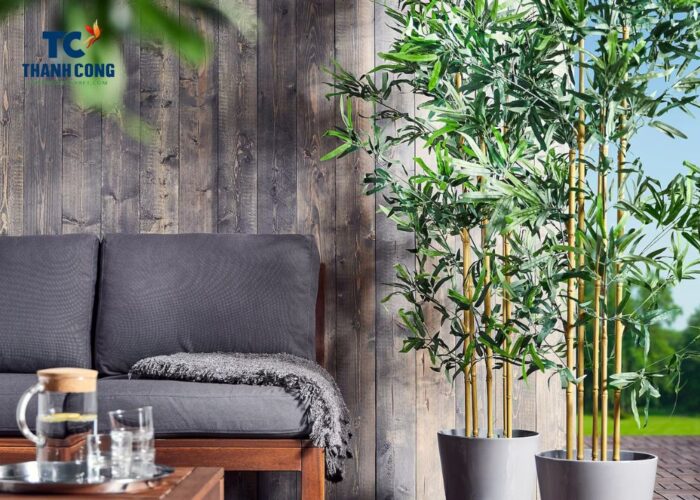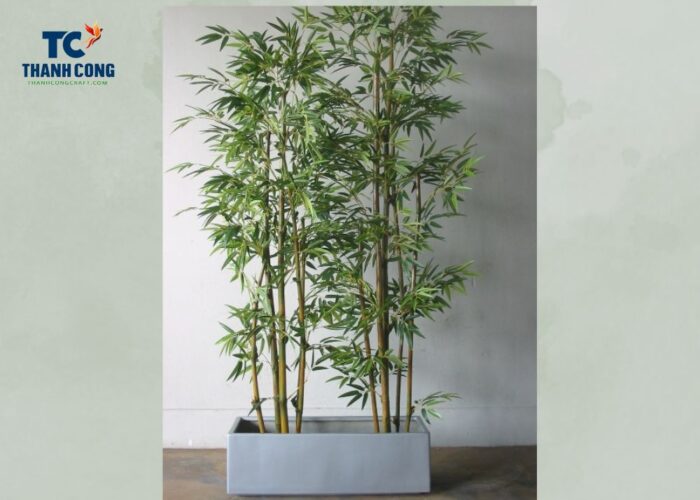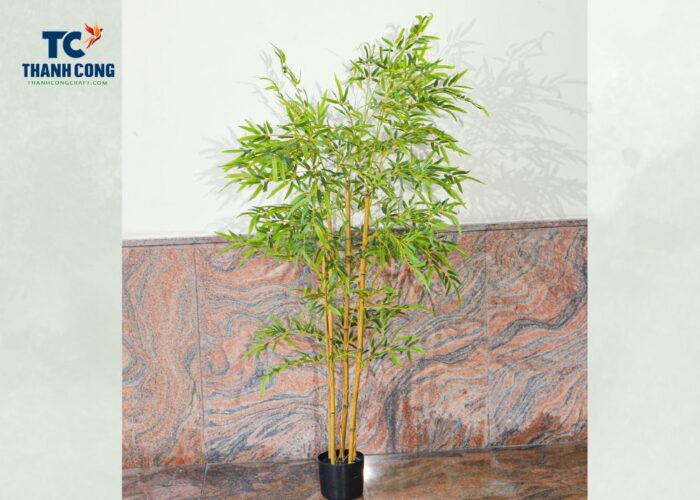-
06-09-2023, 05:01 PM #1
 Silver member
Silver member
- Ngày tham gia
- Nov 2015
- Bài viết
- 88
Uses Of Bamboo Plant In Home, Where To Keep Bamboo Plant In Home
Renowned for its strength, flexibility, and rapid growth, the bamboo plant has earned its place as a cherished asset in countless cultures around the world. Beyond its aesthetic appeal and symbolic significance, bamboo boasts a multitude of practical applications within the confines of our homes. Let’s explore the uses of bamboo plants in homes in the article below!
1. Uses Of Bamboo Plant In Home
1.1. Bamboo Plant Purifies the Air
Bamboo plants are selected for decorative purposes to infuse homes, offices, workplaces, and other spaces with a revitalizing and airy atmosphere. Recognized for their robust vitality and swift growth, bamboo plants are a favored option for both outdoor and indoor cultivation, elevating aesthetic charm. Notably, bamboo plants excel at air purification, effectively eliminating harmful pollutants such as carbon monoxide, benzene, toluene, formaldehyde, and more.

Bamboo plants are selected for decorative purposes to infuse homes
1.2. Bamboo Plant Boosts Your Home’s Aesthetic Value
In the realm of interior and exterior design, the incorporation of natural elements has become an increasingly popular trend. Among these elements, bamboo stands out as a versatile and captivating choice that can significantly enhance the aesthetic value of your home. With its unique characteristics and visual appeal, bamboo plants have found their way into various living spaces, bringing a touch of nature’s beauty indoors.
Whether you choose to place bamboo plants in pots, vases, or even as part of larger landscape designs, they seamlessly blend with different settings. Their versatility allows them to enhance both indoor and outdoor spaces.
>> See more:- 20 uses of bamboo
- 10 example of bamboo products
- Bamboo leaves medicinal uses
1.3. Bamboo Plant is Easy to Grow
According to Eastern culture, the robust vitality and resilience of this remarkable plant symbolize the enduring traditional values passed down through generations. It’s for this reason that ornamental bamboo plants are widely cultivated in Vietnam in particular, and in some countries in the region in general.
However, when cultivating bamboo, attention must be paid to the innate growth habits of this plant. Bamboo grows rapidly, often taking just 4 months to transition from a shoot to a fully mature plant. It thrives best in warm and humid climates, growing astonishingly fast.
Nonetheless, this rapid growth can also be a weakness. Uncontrolled growth and excessive height can lead to concerns about disrupting ecological balance and the safety of structures. It’s essential to carefully consider these aspects.
1.4. Bamboo Plant Tea Aids in Digestion
A little-known feature of bamboo leaves is their ability to support digestion through the presence of anthraquinone compounds. These compounds assist in softening stool by allowing water to be reabsorbed into the colon after chloride secretion to the intestines. Additionally, bamboo leaf water enhances intestinal motility, aiding those with constipation in easier waste elimination. However, excessive consumption of bamboo leaf water can also lead to diarrhea.
1.5. Bamboo Plant Attracts Positivity
Bamboo plants are renowned for their ability to bring health, happiness, love, and prosperity. People often cultivate bamboo plants in their gardens or offices to enhance positive energy, thereby creating a comfortable and secure living space. Moreover, bamboo plants contribute to creating a refreshing, cool, and pleasant atmosphere. For this reason, consider growing them in hallways within your home, in offices, shops, or placing them on work desks. If you’re not keen on growing actual bamboo plants, you can also hang paintings of bamboo to attract these positive attributes.
1.6. Bamboo Plant is a Good Luck Charm
In cultures across the globe, the bamboo plant is revered not only for its natural beauty but also for its ability to bestow good luck and positive energy upon its surroundings. As a symbol of resilience, growth, and prosperity, the bamboo plant has earned its place as a cherished emblem of fortune. The bamboo plant’s association with good luck traces back centuries, often seen as an auspicious addition to homes, offices, and businesses.
1.7. Bamboo Plant Can Help You Stay Healthy
The bamboo plant’s innate ability to purify the air is a boon for indoor environments. Through a process called phytoremediation, bamboo absorbs pollutants and toxins, helping to improve indoor air quality. Its presence in your living spaces can lead to fresher, cleaner air and reduced allergens. From air purification to enhancing mental wellness, the bamboo plant offers a range of health benefits that extend beyond its graceful appearance.
1.8. Where to keep lucky bamboo plant in home
Where to keep bamboo plant in home because the lucky bamboo plant is considered a highly fortunate and auspicious feng shui plant. It is believed that having the bamboo plant in homes and offices can attract luck, wealth, and prosperity.

It is believed that having the bamboo plant in homes
Placing the lucky bamboo plant indoors, whether at home or in the workplace, is thought to bring about peaceful energy. It represents flexibility and freedom. The arrangement of the bamboo plant also symbolizes the earth element, the foundation of a harmonious universe.
It is thought that, where to put bamboo plant in home the bamboo plant aids in the circulation of positive energy, thereby generating abundance and affluence. Furthermore, the bamboo’s tubular structure signifies the wisdom of allowing energy to flow from within to the outer world.
1.9. Bamboo Plant Reinforces Balance
The presence of bamboo plants in our living spaces creates an environment of serenity and calm. The soothing greenery and gentle rustling of leaves invoke a sense of tranquility, helping us find balance amidst the demands of modern life.
2. Tips On Taking Care Of Your Bamboo Plant
For pre-purchased bamboo plant varieties, you won’t need to fertilize them during the first approximately 3 months. The nutrients from the initial potting mix are sufficient for this initial period, so focus on providing proper watering to support healthy growth and development.

For pre-purchased bamboo plant varieties
As bamboo is a moisture-loving plant, water it until you notice water flowing out from the bottom of the pot, then stop. To maintain the plant’s vibrant green color, consider exposing it to sunlight for a few hours each day. This aids in photosynthesis and positively impacts the plant’s growth process. Due to bamboo’s rapid growth, remember to trim any excessively long or unsightly branches to shape the plant according to your preference.
3. What Are The Disadvantages Of Bamboo Plants At Home?
While bamboo plants are often celebrated for their beauty, symbolism, and various benefits, it’s important to consider both sides of the coin. Just like any other living element in your living space, bamboo plants come with their own set of disadvantages. Let’s delve into some potential drawbacks of having bamboo plants at home:- Invasive Growth: Bamboo’s rapid growth can be both a blessing and a curse. Some bamboo varieties are known for their invasive nature, sending out runners that can quickly take over your garden or yard if not properly contained. This aggressive growth can potentially disrupt other plants and ecosystems.
- Space Constraints: In indoor environments, certain bamboo species might outgrow the available space sooner than expected. Without regular trimming and maintenance, they can become too large for their containers or allotted areas.
- Susceptibility to Pests: Although generally hardy, bamboo plants can fall victim to pests and diseases. Inadequate care or an unfavorable environment can weaken the plant, making it susceptible to spider mites, mealybugs, and fungal infections.
Source: Where to keep bamboo plant in homeView more random threads:
- Bác sĩ chuyên cắt mí tại Quảng Ngãi
- Bánh bao vừa thơm vừa ngon như mơ - Tạo điểm khác biệt từ C.ty bài bản
- Dìu dặt tiếng khèn Mông
- đọc truyện không phải là thói quen xấu như bạn vẫn tưởng
- Địa chỉ nâng mũi uy tín tại Quảng Ngãi
- #2 Tìm hiểu Thượng mã phong khi quan hệ tình dục cần làm gì?
- Bán nhà tại quốc lộ 31, Bắc Giang
- Đánh giá về những video phẫu thuật thẩm mỹ vùng kín tại Đà Nẵng
- Có nên mua Tủ Nhựa Đựng Đồ Quần Áo tại Gỗ Trang Trí không?
- Đón chờ siêu hit phá đảo mùa hè từ nhà cái cá cược Yes8vn
Các Chủ đề tương tự
-
Illuminating Spaces: The Beauty of Bamboo Pendant Light Shade
Bởi Thanhcongcraft trong diễn đàn Rao vặt tổng hợpTrả lời: 0Bài viết cuối: 29-08-2023, 03:43 PM -
Crafting Elegance: The Square Bamboo Basket Solution
Bởi Thanhcongcraft trong diễn đàn Rao vặt tổng hợpTrả lời: 0Bài viết cuối: 04-08-2023, 02:28 PM -
Natural Delight Bamboo Fruit Basket
Bởi Thanhcongcraft trong diễn đàn Rao vặt tổng hợpTrả lời: 0Bài viết cuối: 18-07-2023, 04:39 PM -
Tiềm năng đầu tư dự án Happy Home Cà Mau
Bởi Tenten trong diễn đàn Các tài nguyên khácTrả lời: 0Bài viết cuối: 26-12-2020, 04:33 PM -
Đất Lô Nền Happy Home Cà Mau xuất hiện Mức giá bán 1 tỷ 3
Bởi Tenten trong diễn đàn Các tài nguyên khácTrả lời: 0Bài viết cuối: 01-12-2020, 07:38 PM



 Trả lời kèm Trích dẫn
Trả lời kèm Trích dẫn





Trong làng giải trí trực tuyến hiện nay, việc tìm kiếm 1 nơi đáng tin cậy để thư giãn và trải nghiệm các trò chơi giải trí là điều không hề dễ dàng. ngoài ra, có một địa chỉ đã từng bước khẳng định...
Giới thiệu sự an toàn của sân chơi...